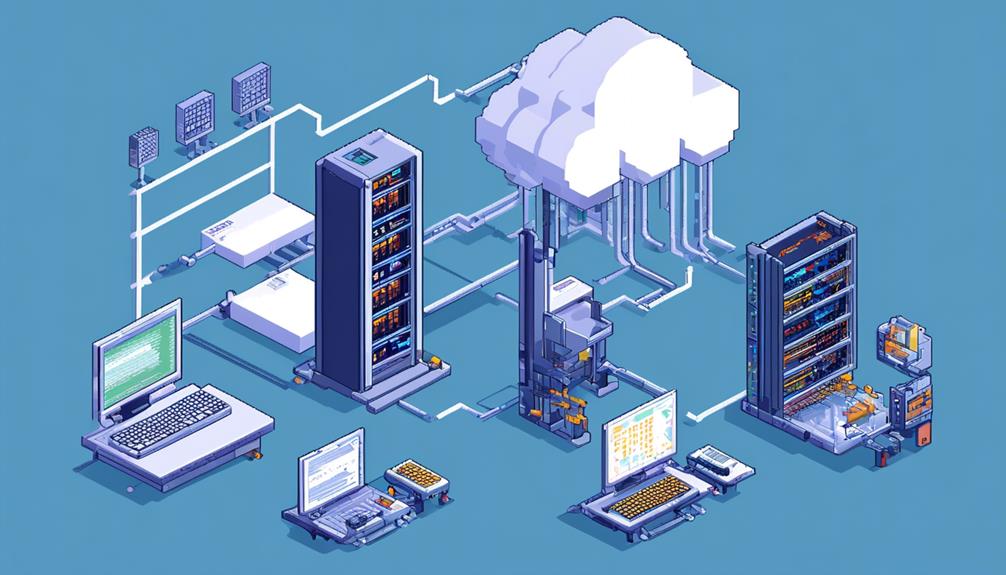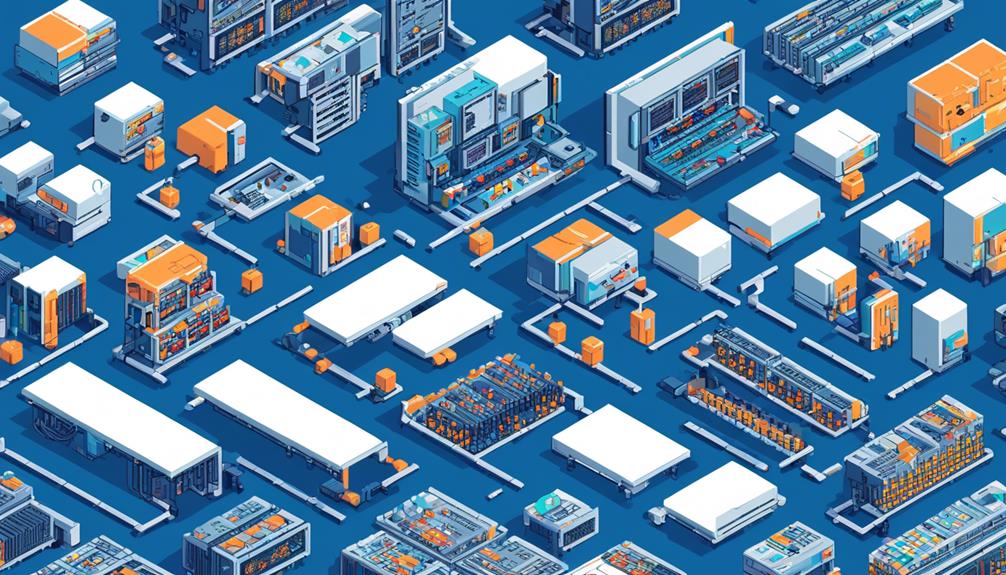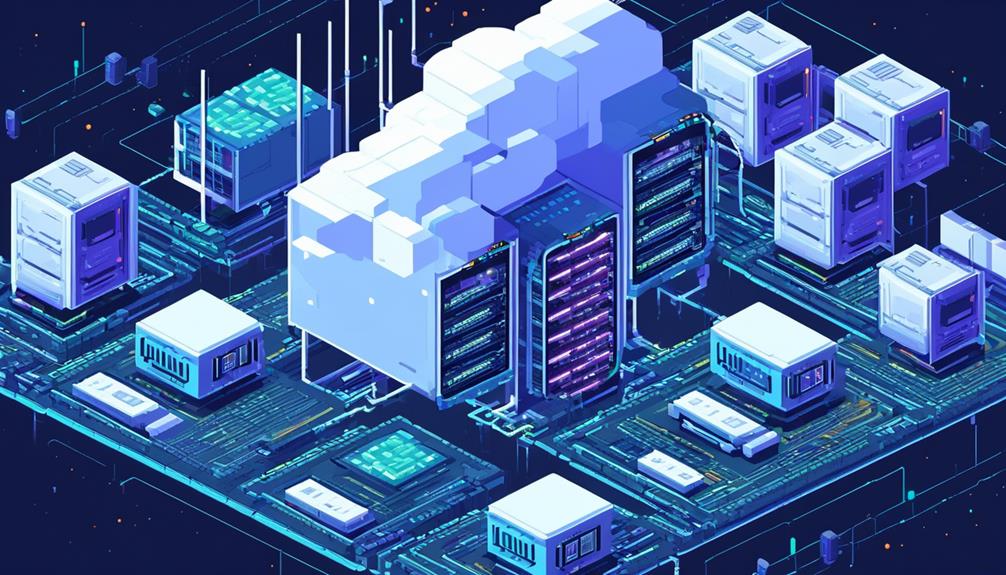In the ever-evolving landscape of cloud computing, hardware scaling stands as a crucial aspect that demands our attention. This practice enables organizations to dynamically adjust their hardware resources, ensuring optimal performance in the face of fluctuating workloads and changing demands.
While the concept of hardware scaling may seem straightforward, it encompasses a multitude of considerations, challenges, and best practices. By delving into the intricacies of hardware scaling, we can uncover the benefits it brings to cloud computing, explore the tools and technologies that facilitate its implementation, and examine real-world case studies that exemplify successful scaling strategies.
Moreover, we will also discuss the future trends that promise to further enhance the capabilities of hardware scaling, leaving us with a sense of anticipation for what lies ahead in this realm.
Key Takeaways
- Hardware scaling is crucial for long-term growth, resource optimization, and cost reduction in cloud computing.
- There are different types of hardware scaling, including vertical, horizontal, and diagonal scalability.
- Cost-effective scalability involves efficient resource allocation, capacity planning, and cost optimization.
- Performance optimization considers CPU, memory, storage, and network performance, and scalability testing helps identify bottlenecks and fine-tune resources.
Importance of Hardware Scaling

The importance of hardware scaling in cloud computing cannot be overstated as it is crucial for long-term growth and flexibility in managing resources. Hardware scaling refers to the ability to add or remove hardware resources, such as servers, to accommodate changing workloads and demands effectively. This scalability is a fundamental aspect of cloud computing, enabling businesses to optimize resource utilization, reduce waste, and avoid the upfront costs associated with purchasing expensive equipment.
In cloud computing, the capacity to scale hardware resources is essential for maintaining optimal performance. By dynamically adjusting the number of servers in response to workload fluctuations, businesses can ensure that their applications and services continue to run smoothly, even during periods of increased demand. This ability to scale resources up or down in real-time allows for efficient resource allocation, ensuring that businesses only pay for what they actually use.
Moreover, scalable hardware resources in cloud computing enable businesses to adapt quickly to sudden or gradual increases in traffic or workload demands. This agility is particularly valuable for companies with agile and scalable business models, as it allows them to rapidly expand their operations and stay competitive in a fast-paced market.
Types of Hardware Scaling
Vertical scalability, also known as scaled-up scalability, involves adding or subtracting resources within a single server to improve performance and capacity. It allows for quick and easy resource management, as resources can be easily added or removed as long as there is capacity. On the other hand, horizontal scalability, also known as scaled-out scalability, involves adding more servers to the network to efficiently handle increased traffic and concurrent workloads. This type of scalability is important for high availability services with minimal downtime, as it spreads out the workload across multiple servers.
Another type of scalability is diagonal scalability, which is a combination of vertical and horizontal scalability. Diagonal scalability provides an efficient infrastructure scaling for handling a large volume of requests and traffic. It combines the benefits of both vertical and horizontal scaling, allowing for both resource expansion within a single server and the addition of more servers to the network.
To provide a visual representation of these types of hardware scaling, the following table summarizes the key characteristics of each:
| Type of Hardware Scaling | Definition | Key Characteristics |
|---|---|---|
| Vertical Scalability | Scaled-up scalability, adding or subtracting resources within a single server | Quick resource management, capacity-dependent |
| Horizontal Scalability | Scaled-out scalability, adding more servers to the network | High availability, workload distribution |
| Diagonal Scalability | Combination of vertical and horizontal scalability | Efficient infrastructure scaling, handling large volume of requests |
When considering scalability in cloud computing, it is essential to choose a scalable cloud solution that can automatically scale resources based on workload demands. By leveraging the scalability provided by cloud service providers, organizations can optimize their resource allocation, minimize physical machine utilization, and reduce disaster recovery costs.
Considerations for Hardware Scaling

When considering hardware scaling in cloud computing, there are two important considerations: cost-effective scalability and performance optimization.
Cost-effective scalability involves ensuring that the resources being scaled can meet increasing demand without incurring excessive costs. This can be achieved through efficient resource allocation, utilization monitoring, and capacity planning.
Performance optimization, on the other hand, focuses on maximizing the efficiency and responsiveness of the scaled hardware to deliver optimal performance to end-users. This involves careful hardware selection, configuration tuning, and performance testing to identify and eliminate bottlenecks.
Cost-Effective Scalability
Cost-effective scalability in hardware scaling is a crucial consideration for businesses aiming to efficiently meet changing IT resource needs. When it comes to cloud computing, there are several key factors to consider:
- Horizontal scaling: Cloud scalability benefits from horizontal scaling, which involves adding more resources by increasing the number of virtual machines or instances. This allows businesses to handle increased workload demands without compromising performance.
- Vertical scaling: Another approach is vertical scaling, which involves increasing the power and storage capacity of individual virtual machines or physical machines. This allows businesses to handle more resource-intensive applications and data processing.
- Scalability testing: Before implementing cloud scalability, businesses need to conduct thorough scalability testing to ensure that their applications can handle the increased workload. This involves simulating high traffic scenarios and monitoring system performance and responsiveness.
- Cost optimization: Cloud providers offer different pricing models for scalability, and businesses need to carefully evaluate the cost implications of scaling their infrastructure. It is important to find the right balance between meeting resource demands and minimizing costs.
Cost-effective scalability is one of the hallmarks of the cloud, enabling businesses to efficiently add more resources as needed and adapt to changing demands while optimizing costs.
Performance Optimization
Performance optimization is a critical factor in hardware scaling, ensuring efficient utilization of resources and maximizing system capabilities. When considering scalability in cloud computing, there are two main approaches: horizontal scaling and vertical scaling.
Horizontal scaling involves adding more virtual machines to distribute the workload across multiple servers, while vertical scaling involves upgrading the hardware of existing servers to handle higher workload demands.
To optimize performance, careful consideration must be given to various infrastructure components, including CPU, memory, storage, and network performance. Scalability testing and performance optimization techniques can help identify bottlenecks and fine-tune the resources accordingly.
Automation and orchestration tools play a vital role in dynamically adjusting hardware resources based on real-time performance metrics. By optimizing processing power and resource allocation, organizations can achieve optimal performance in cloud computing environments.
Benefits of Hardware Scaling in Cloud Computing
Hardware scaling in cloud computing offers numerous benefits that enable businesses to quickly respond to changing demands, optimize resource utilization, and achieve scalable growth. Here are four key benefits of hardware scaling in cloud computing:
- Cost Savings: Scalable cloud solutions eliminate the need for businesses to invest in expensive physical machines. Instead, businesses can rely on virtual machines that can be easily scaled up or down based on demand. This eliminates upfront costs and reduces waste, resulting in significant cost savings.
- Optimized Resource Utilization: Scalability in cloud computing allows businesses to optimize resource utilization by dynamically allocating resources based on workload demands. This ensures that computing resources are efficiently utilized, reducing the risk of underutilization or overutilization.
- Increased Flexibility: Hardware scaling enables businesses to easily scale their cloud architecture horizontally, adding more virtual machines to meet increased workload demands. This flexibility allows businesses to quickly adapt to changing market conditions and customer needs without disrupting operations.
- Improved Disaster Recovery: Hardware scaling in cloud computing provides businesses with enhanced disaster recovery capabilities. By leveraging the ability to scale, businesses can replicate their data and applications across multiple virtual machines, reducing the risk of data loss and minimizing disaster recovery costs.
Challenges of Hardware Scaling in Cloud Computing

One of the primary challenges associated with hardware scaling in cloud computing is ensuring seamless integration and compatibility between the existing hardware infrastructure and the scalable cloud architecture. While cloud computing offers the benefits of scalability and elasticity, businesses must carefully consider the challenges they may face in achieving hardware scaling.
One challenge is determining the optimal approach to scaling: vertical scaling or horizontal scaling. Vertical scaling involves increasing the capacity of individual physical machines, such as adding more memory or processing power. On the other hand, horizontal scaling involves adding more physical machines to the cloud infrastructure. Each approach has its own advantages and disadvantages, and businesses must carefully evaluate their specific workload demands to determine the most suitable scaling strategy.
Another challenge is the potential increase in disaster recovery costs. As businesses scale their hardware infrastructure in the cloud, they need to ensure that disaster recovery processes and mechanisms are in place to protect their data and applications. This may involve additional investments in redundant hardware, backup systems, and disaster recovery plans to minimize the risk of data loss or downtime.
Furthermore, ensuring compatibility between the existing hardware infrastructure and the scalable cloud architecture can be a complex task. Businesses may need to upgrade or replace their existing hardware to ensure compatibility with the cloud environment. This can involve significant costs and technical challenges, such as ensuring proper integration with existing systems and applications.
Best Practices for Hardware Scaling
To ensure efficient hardware scaling in cloud computing, it is essential to implement best practices that optimize resource allocation, monitor performance metrics, and utilize scalability features based on demand and usage patterns. Here are four best practices for hardware scaling in the cloud:
- Plan for scalability from the start:
When designing a scalable cloud solution, it is crucial to consider flexibility, horizontal scalability, and fault tolerance. By implementing a modular and decoupled architecture, you can allocate resources granularly and adapt to changing workload demands.
- Monitor and optimize performance metrics:
Regularly monitoring performance metrics and key indicators allows you to identify and address any issues that may impact scalability. By improving database queries, tuning application configurations, and implementing caching strategies, you can optimize performance and ensure efficient hardware scaling.
- Utilize auto-scaling and predictive scaling:
Leveraging scalability features such as auto-scaling and predictive scaling based on demand and usage patterns can help you effectively manage resource allocation. These features allow virtual machines (VMs) to automatically scale up or down based on workload demands, ensuring optimal performance while minimizing costs.
- Conduct scalability testing and disaster recovery planning:
It is important to perform scalability testing to validate the effectiveness of your cloud architecture. This involves simulating high workloads and measuring system performance to ensure it meets scalability requirements. Additionally, having a disaster recovery plan in place is crucial to ensure business continuity in the event of hardware failures or other disruptions.
Tools and Technologies for Hardware Scaling

When considering the efficient implementation of hardware scaling in cloud computing, it is crucial to explore the various tools and technologies available for optimizing resource allocation and managing workload demands. Hardware scaling in cloud computing is essential for achieving scalability, which refers to the ability to handle increasing workload demands by adding or removing resources. There are several tools and technologies that can assist in achieving hardware scaling in cloud computing environments.
One of the fundamental tools for hardware scaling is virtualization. Virtualization enables the creation and management of virtual machines (VMs) that can be easily scaled up or down to accommodate changing demands. By abstracting the underlying hardware, virtual machines provide flexibility in resource allocation and capacity planning.
Containerization is another technology that plays a crucial role in hardware scaling. Containers allow for the efficient packaging and deployment of software applications, making it easier to scale horizontally by adding more instances of the application. Container orchestration tools like Kubernetes provide automated management and scaling of containers, ensuring that the workload is evenly distributed across the infrastructure.
Auto-scaling is a technique that automatically adjusts the resources allocated to an application based on predefined rules and metrics. By monitoring system performance and workload demands, auto-scaling ensures that the necessary resources are available to handle increased traffic or workload spikes.
Load balancing is another essential tool for hardware scaling. It distributes incoming network traffic across multiple servers to optimize resource utilization and prevent overloading of individual machines. Load balancing algorithms can be configured to adapt dynamically to changing workload demands, ensuring efficient resource allocation.
Case Studies of Successful Hardware Scaling
Successful hardware scaling case studies provide valuable insights into how businesses effectively increased their computing power and resources to meet growing demands in cloud computing environments. These case studies showcase the strategic implementation of hardware upgrades and expansions to support business growth and adapt to changing needs. Here are four notable examples:
- Netflix: As a leading provider of streaming services, Netflix experienced exponential growth in its user base. To handle this increasing demand, Netflix adopted a hardware scaling approach by leveraging cloud computing. By utilizing Amazon Web Services (AWS), Netflix was able to scale its server capacity dynamically to accommodate spikes in user traffic. This allowed them to deliver a seamless streaming experience while maintaining cost efficiency.
- Spotify: Spotify, a popular music streaming platform, faced the challenge of handling a massive number of concurrent users and an ever-expanding music library. To address this, Spotify implemented a hardware scaling strategy by adopting a distributed system architecture. By distributing its music library across multiple servers, Spotify achieved scalability and improved response times, ensuring a smooth and uninterrupted music streaming experience for its users.
- Airbnb: Airbnb, an online marketplace for lodging and vacation rentals, experienced rapid growth in its user base and property listings. To meet the increasing demand, Airbnb embraced a hardware scaling approach by utilizing cloud computing services such as AWS. By leveraging cloud elasticity, Airbnb was able to scale its infrastructure on demand, ensuring a reliable and seamless booking experience for its users.
- Uber: Uber, a ride-hailing platform, faced the challenge of handling millions of real-time requests from users across the globe. To address this, Uber adopted a hardware scaling strategy by building a highly scalable and distributed system. By implementing a microservices architecture and utilizing containerization technologies like Docker, Uber achieved the scalability and elasticity needed to handle the massive workload, ensuring a smooth and efficient ride-hailing experience.
These case studies demonstrate the positive impact of hardware scaling in cloud computing environments. By effectively scaling their hardware infrastructure, these businesses achieved improved performance, cost efficiency, and resource utilization. They serve as valuable examples for organizations looking to implement hardware scaling strategies to meet the growing demands of cloud computing.
Future Trends in Hardware Scaling for Cloud Computing

As cloud computing continues to evolve, scalability challenges and solutions are at the forefront of future trends in hardware scaling.
Organizations are seeking ways to efficiently scale their cloud infrastructure to meet increasing demands, while also managing costs and maintaining high performance.
Emerging hardware technologies, such as specialized processors and accelerators, are being developed to address these challenges and optimize cloud performance.
The impact of these advancements on cloud computing will be significant, leading to faster processing speeds, improved efficiency, and enhanced scalability for businesses of all sizes.
Scalability Challenges and Solutions
To address the future challenges of hardware scaling in cloud computing, innovative solutions are being developed to enhance the scalability and efficiency of the cloud environment.
These solutions aim to overcome the following challenges:
- Scalable Cloud: Scaling hardware resources in the cloud can be complex due to the need for seamless integration with existing infrastructure. Solutions are being developed to enable easy scalability and provisioning of resources, allowing businesses to rapidly adjust their server capacity to meet changing demands.
- Vertical Scaling: Traditional scaling approaches involve adding more resources to a single server, but this can be limited by hardware constraints. To overcome this challenge, hardware scaling solutions are being designed to enable vertical scaling, which involves increasing the capacity of individual servers to handle larger workloads.
- Horizontal Scaling: Adding more servers to distribute the workload is a popular approach to achieving scalability. However, this introduces challenges such as load balancing and synchronization. Solutions are being developed to automate the process of horizontal scaling, ensuring efficient resource allocation and workload distribution.
- Elasticity: Cloud elasticity refers to the ability to automatically scale resources up or down based on demand. Developing solutions that enable seamless and dynamic scaling of hardware resources is essential to achieve optimal resource utilization and cost efficiency in the cloud environment.
Emerging Hardware Technologies
The future of hardware scaling for cloud computing is being shaped by emerging hardware technologies. These technologies aim to enhance scalability and efficiency in the cloud environment.
Advancements in virtualization and containerization technologies will play a crucial role in future trends in hardware scaling for cloud computing. These technologies enable the efficient allocation of resources and the seamless deployment of applications in the cloud.
Quantum computing and edge computing are also emerging hardware technologies that will impact the scalability of the cloud. Quantum computing has the potential to solve complex problems at an unprecedented speed, while edge computing brings computing power closer to the data source, reducing latency and improving scalability.
Hardware acceleration through specialized processors like GPUs and TPUs will be key in meeting the demands of a scalable cloud infrastructure. These processors are designed to handle intensive workloads and optimize performance, allowing for faster data processing and analysis in the cloud.
Additionally, the integration of AI and machine learning into hardware infrastructure will drive future trends in hardware scaling for cloud computing. AI and machine learning algorithms require significant computational power, and hardware optimizations will be crucial to support these technologies at scale.
To ensure the success of these emerging hardware technologies, scalability testing and the design of efficient cloud architectures will be essential. Scalability testing will help identify and address bottlenecks in the hardware infrastructure, while efficient cloud architectures will enable the seamless integration and management of hardware resources in the cloud environment.
Impact on Cloud Performance
Cloud performance is significantly influenced by the future trends in hardware scaling for cloud computing, as it enables greater flexibility and resource optimization. Here are four key impacts of hardware scaling on cloud performance:
- Scalable cloud solutions: Hardware scaling allows cloud providers to rapidly scale with vast hardware and software resources. This scalability offers convenience, flexibility, cost savings, and disaster recovery benefits.
- Horizontal scaling: Hardware scaling enables the ability to increase power and storage by adding more physical machines or virtual machines to the existing cloud architecture. This horizontal scaling ensures the resources already in place can handle increased demand.
- Scalable business models: Hardware scaling facilitates scalability testing, driving cloud adoption and enabling businesses to eliminate the need for setting up physical hardware. This allows companies to focus on their core competencies without worrying about high-powered resources.
- Elasticity and scalability: With hardware scaling, cloud environments have the ability to increase or decrease resources according to demand. This elasticity and scalability ensure optimal performance and resource utilization in the cloud.
Frequently Asked Questions
What Is Scaling in Cloud Computing?
Scaling in cloud computing refers to the ability to adjust IT resources to meet changing demands. It offers numerous benefits, including improved flexibility, cost efficiency, and enhanced performance.
However, common challenges in scaling cloud environments include ensuring effective resource allocation, addressing security considerations, and managing performance and cost.
Best practices involve automating scaling using tools and technologies, implementing proper resource allocation strategies, and considering scalability options offered by different cloud providers.
Future trends in scaling techniques aim to further optimize performance and cost while accommodating evolving business needs.
What Is the Hardware in Cloud Computing?
Hardware components in a cloud environment play a crucial role in enabling the scalability and performance of cloud computing.
Physical servers form the foundation of cloud infrastructure, hosting virtual machines and providing computational resources.
Virtualization technology allows for efficient utilization of hardware resources, leading to cost savings and flexibility.
Hardware optimization is essential for maximizing the efficiency and reliability of cloud deployments.
Different types of cloud services have varying hardware requirements, and network devices play a vital role in connecting and managing cloud resources.
Evaluating and improving the performance of hardware in cloud environments is a continuous process.
Future trends in hardware advancements will further enhance the capabilities and scalability of cloud computing.
What Is the Difference Between Scaling in and Scaling Out Cloud Computing?
Scaling in and scaling out are two different approaches to achieving scalability in cloud computing.
Vertical scaling involves adding or removing resources within a single server to improve performance.
Horizontal scaling, on the other hand, adds more servers to handle increased traffic and workloads.
Scaling in cloud environments offers benefits such as improved resource utilization and cost efficiency.
However, it can also present challenges in managing scalability issues.
Auto scaling plays a crucial role in cloud computing by dynamically adjusting resources based on demand.
Implementing scaling in strategies requires careful planning and best practices to optimize application performance and minimize costs.
Is Cloud Computing Horizontal Scaling?
Cloud computing allows for both horizontal and vertical scaling.
Horizontal scaling, also known as scaling out, involves adding more machines to distribute the workload. This method offers advantages such as increased availability, fault tolerance, and improved performance. However, it also presents challenges in terms of data consistency and complexity in managing multiple instances.
Implementing horizontal scaling requires careful consideration of load balancing, data partitioning, and distributed caching. Additionally, cost implications, performance considerations, and limitations should be taken into account when deciding on the scaling method.
Future trends in horizontal scaling include the use of containerization and serverless computing.

